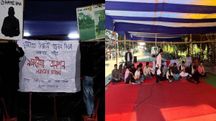Assam: First-ever primate survey flags off in Dehing Patkai with special focus on Hoolock gibbon and Slow Loris
For the first time, a comprehensive survey of non-human primate species is being conducted in Dehing Patkai National Park. The survey focuses on the western Hoolock gibbon and Bengal Slow Loris, aiming to aid in the park's management plan.

The Primate Research Centre NE India / Conservation Himalayas, in collaboration with SACON (South India Centre of Wildlife Institute of India) and the Assam Forest Department, has commenced a field survey to estimate the population of non-human primate species, with a special focus on the western Hoolock gibbon and Bengal Slow Loris, in Dehing Patkai National Park from April 2024 and will continue until May 2024 covering entire Dehing Patkai National Park.
This survey marks the first systematic effort to cover the entire area of the newly designated National Park, where Hoolock gibbon is the flagship species.
The survey was headed by Dr Jihosuo Biswas, Sr. Scientist, Primate Research Centre NE India/Conservation Himalayas and Dr HN Kumara, Principal Scientist, SACON.
The main objectives of the study are to know the population status and demographic details of Hoolock gibbons and other primate species found in the Dehing Patkai National Park and to evaluate the available habitat for Hoolock gibbons and other primate species including to assist the forest department in developing a management plan for the park.
For the exercise, a day-long Census Technique Workshop has been organized on April 23, 2024, at Joypur Forest IB. Altogether 10 enumerators from PRCNE/CH and SACON, along with 26 forest personnel, were trained for field techniques on primate census estimation.
Also Read: Assam: 3 friends disappear while swimming in Manas National Park; one body recovered
The program was inaugurated by the Divisional Forest Officer, Dibrugarh Division, Sandeep Bantale, in the presence of ACF, Dibrugarh Division Amol R Bordhe, and Primatologist Dr Jayanta Das of Wildlife Areas Development and Welfare Trust (WADWT), Guwahati. During the workshop, Dr. Jihosuo Biswas and Dr. Jayanta Das explained in detail about different census techniques to be employed in the survey, including line transect, occupancy, and call count method.
Following the theoretical sessions, practical hands-on training was conducted within the park, allowing trainees to familiarize themselves with various field techniques. Apart from these, the enumeration team have also been trained in operating GPS, map use, compass bearing for call count, and identifying the age and sex of different primate species. A reliability test or reconnaissance survey was performed during the training before undertaking the actual survey to avoid bias.
The census officially commenced on April 24th, 2024, starting from the Jaypur Range of Dibrugarh Division. The survey employed a block count framework using the occupancy method in conjunction with the call count method where counting blocks were subdivided into several counting units by overlaying with 50-hectare grid cells. This approach aimed to establish the spatial occurrence of Hoolock gibbon and other primate species within the park through occupancy modelling.
These counting blocks were surveyed by eight enumeration parties, with each assigned to a few counting units within the counting blocks. Each enumeration party consisted of 3-4 individuals, led by a trained enumerator, accompanied by a local villager, and supported by 1–2 forest personnel. Essential equipment provided to each team included maps, GPS devices, android mobile phones, binoculars, cameras, and wireless handsets. This census marked the first utilization of the occupancy method alongside the call count method within the national park, said Dr. Biswas.
Copyright©2025 Living Media India Limited. For reprint rights: Syndications Today









